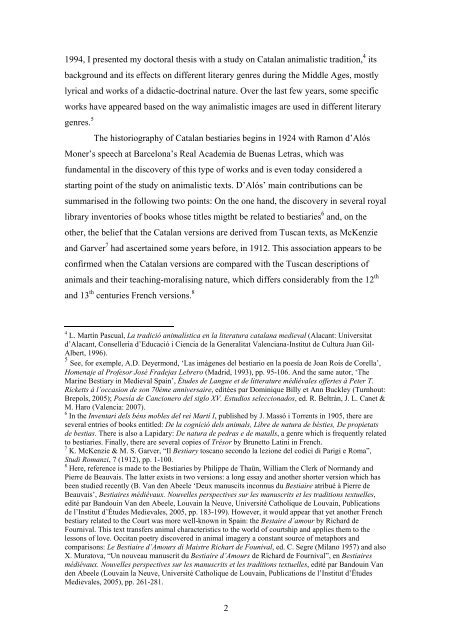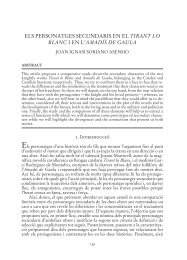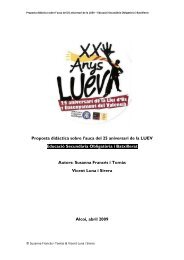Aquatic animals in the Catalan Bestiari - Institut Interuniversitari de ...
Aquatic animals in the Catalan Bestiari - Institut Interuniversitari de ...
Aquatic animals in the Catalan Bestiari - Institut Interuniversitari de ...
You also want an ePaper? Increase the reach of your titles
YUMPU automatically turns print PDFs into web optimized ePapers that Google loves.
1994, I presented my doctoral <strong>the</strong>sis with a study on <strong>Catalan</strong> animalistic tradition, 4 its<br />
background and its effects on different literary genres dur<strong>in</strong>g <strong>the</strong> Middle Ages, mostly<br />
lyrical and works of a didactic-doctr<strong>in</strong>al nature. Over <strong>the</strong> last few years, some specific<br />
works have appeared based on <strong>the</strong> way animalistic images are used <strong>in</strong> different literary<br />
genres. 5<br />
The historiography of <strong>Catalan</strong> bestiaries beg<strong>in</strong>s <strong>in</strong> 1924 with Ramon d’Alós<br />
Moner’s speech at Barcelona’s Real Aca<strong>de</strong>mia <strong>de</strong> Buenas Letras, which was<br />
fundamental <strong>in</strong> <strong>the</strong> discovery of this type of works and is even today consi<strong>de</strong>red a<br />
start<strong>in</strong>g po<strong>in</strong>t of <strong>the</strong> study on animalistic texts. D’Alós’ ma<strong>in</strong> contributions can be<br />
summarised <strong>in</strong> <strong>the</strong> follow<strong>in</strong>g two po<strong>in</strong>ts: On <strong>the</strong> one hand, <strong>the</strong> discovery <strong>in</strong> several royal<br />
library <strong>in</strong>ventories of books whose titles migtht be related to bestiaries 6 and, on <strong>the</strong><br />
o<strong>the</strong>r, <strong>the</strong> belief that <strong>the</strong> <strong>Catalan</strong> versions are <strong>de</strong>rived from Tuscan texts, as McKenzie<br />
and Garver 7 had ascerta<strong>in</strong>ed some years before, <strong>in</strong> 1912. This association appears to be<br />
confirmed when <strong>the</strong> <strong>Catalan</strong> versions are compared with <strong>the</strong> Tuscan <strong>de</strong>scriptions of<br />
<strong>animals</strong> and <strong>the</strong>ir teach<strong>in</strong>g-moralis<strong>in</strong>g nature, which differs consi<strong>de</strong>rably from <strong>the</strong> 12 th<br />
and 13 th centuries French versions. 8<br />
4<br />
L. Martín Pascual, La tradició animalística en la literatura catalana medieval (Alacant: Universitat<br />
d’Alacant, Conselleria d’Educació i Ciencia <strong>de</strong> la Generalitat Valenciana-<strong>Institut</strong> <strong>de</strong> Cultura Juan Gil-<br />
Albert, 1996).<br />
5<br />
See, for exemple, A.D. Deyermond, ‘Las imágenes <strong>de</strong>l bestiario en la poesía <strong>de</strong> Joan Roís <strong>de</strong> Corella’,<br />
Homenaje al Profesor José Fra<strong>de</strong>jas Lebrero (Madrid, 1993), pp. 95-106. And <strong>the</strong> same autor, ‘The<br />
Mar<strong>in</strong>e Bestiary <strong>in</strong> Medieval Spa<strong>in</strong>’, Étu<strong>de</strong>s <strong>de</strong> Langue et <strong>de</strong> litterature médiévales offertes à Peter T.<br />
Ricketts à l’occasion <strong>de</strong> son 70ème anniversaire, editées par Dom<strong>in</strong>ique Billy et Ann Buckley (Turnhout:<br />
Brepols, 2005); Poesía <strong>de</strong> Cancionero <strong>de</strong>l siglo XV. Estudios seleccionados, ed. R. Beltrán, J. L. Canet &<br />
M. Haro (Valencia: 2007).<br />
6<br />
In <strong>the</strong> Inventari <strong>de</strong>ls béns mobles <strong>de</strong>l rei Martí I, published by J. Massó i Torrents <strong>in</strong> 1905, <strong>the</strong>re are<br />
several entries of books entitled: De la cognició <strong>de</strong>ls <strong>animals</strong>, Libre <strong>de</strong> natura <strong>de</strong> bèsties, De propietats<br />
<strong>de</strong> bestias. There is also a Lapidary: De natura <strong>de</strong> pedras e <strong>de</strong> matalls, a genre which is frequently related<br />
to bestiaries. F<strong>in</strong>ally, <strong>the</strong>re are several copies of Trésor by Brunetto Lat<strong>in</strong>i <strong>in</strong> French.<br />
7<br />
K. McKenzie & M. S. Garver, “Il Bestiary toscano secondo la lezione <strong>de</strong>l codici di Parigi e Roma”,<br />
Studi Romanzi, 7 (1912), pp. 1-100.<br />
8<br />
Here, reference is ma<strong>de</strong> to <strong>the</strong> <strong>Bestiari</strong>es by Philippe <strong>de</strong> Thaün, William <strong>the</strong> Clerk of Normandy and<br />
Pierre <strong>de</strong> Beauvais. The latter exists <strong>in</strong> two versions: a long essay and ano<strong>the</strong>r shorter version which has<br />
been studied recently (B. Van <strong>de</strong>n Abeele ‘Deux manuscits <strong>in</strong>connus du Bestiaire atribué à Pierre <strong>de</strong><br />
Beauvais’, Bestiaires médiévaux. Nouvelles perspectives sur les manuscrits et les traditions textuelles,<br />
edité par Bandou<strong>in</strong> Van <strong>de</strong>n Abeele, Louva<strong>in</strong> la Neuve, Université Catholique <strong>de</strong> Louva<strong>in</strong>, Publications<br />
<strong>de</strong> l’<strong>Institut</strong> d’Étu<strong>de</strong>s Medievales, 2005, pp. 183-199). However, it would appear that yet ano<strong>the</strong>r French<br />
bestiary related to <strong>the</strong> Court was more well-known <strong>in</strong> Spa<strong>in</strong>: <strong>the</strong> Bestaire d’amour by Richard <strong>de</strong><br />
Fournival. This text transfers animal characteristics to <strong>the</strong> world of courtship and applies <strong>the</strong>m to <strong>the</strong><br />
lessons of love. Occitan poetry discovered <strong>in</strong> animal imagery a constant source of metaphors and<br />
comparisons: Le Bestiaire d’Amours di Maistre Richart <strong>de</strong> Founival, ed. C. Segre (Milano 1957) and also<br />
X. Muratova, “Un nouveau manuscrit du Bestiaire d’Amours <strong>de</strong> Richard <strong>de</strong> Fournival”, en Bestiaires<br />
médiévaux. Nouvelles perspectives sur les manuscrits et les traditions textuelles, edité par Bandou<strong>in</strong> Van<br />
<strong>de</strong>n Abeele (Louva<strong>in</strong> la Neuve, Université Catholique <strong>de</strong> Louva<strong>in</strong>, Publications <strong>de</strong> l’<strong>Institut</strong> d’Étu<strong>de</strong>s<br />
Medievales, 2005), pp. 261-281.<br />
2




